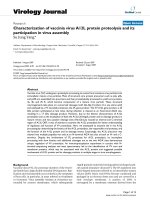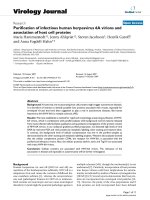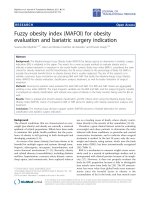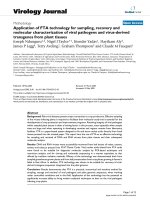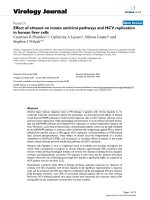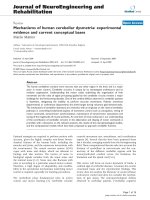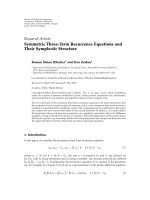Báo cáo sinh học: "Estimation of covariance components between one continuous and one binary trait" pot
Bạn đang xem bản rút gọn của tài liệu. Xem và tải ngay bản đầy đủ của tài liệu tại đây (622.96 KB, 13 trang )
Original
article
Estimation
of
covariance
components
between
one
continuous
and
one
binary
trait
H.
Simianer
L.R.
Schaeffer
2
Justus
Liebig
University,
Department
of
Animal
Breeding
and
Genetics,
Bismarckstr.
16
D-6300
Giessen,
FRG
2
University
of Guelph,
Department
of Animal
and
Poultry
Science,
Guelph,
Ontario
N1G
2W1
Canada
(received
17
December
1987,
accepted
14
October
1988)
Summary -
A
method
is
described
to
estimate
variance
and
covariance
components
in
a
multiple
trait
situation
with
one
continuous
and
one
binary
trait.
An
underlying
bivariate
normal
distribution
is
assumed
with
one
variable
dichotomized
on
the
observable
scale
through
a
fixed
threshold.
A
mixed
linear
model
is
applied
to
the
underlying
scale,
and
Bayesian
arguments
are
employed
to
derive
estimation
procedures
for
both
location
and
dispersion
parameters.
This
leads
to
a
nonlinear
system
of
equations
similar
to
the
mixed
model
equations
for
observations
that
have
been
transformed
by
a
Cholesky
decomposition
of
the
residual
variance-covariance
matrix
so
that the
residual
covariance
between
the
two
transformed
traits
is
zero,
thereby
simplifying
construction
of
the
multiple
trait
mixed
model
equations.
The
procedures
for
estimating
genetic
variances
and
covariances
and
the
residual
variance
for
the
continuous
trait
are
equivalent
to
restricted
maximum
likelihood
in
the
multivariate
normal
case.
The
residual correlation
is
estimated
using
a
maximum
likelihood
approach.
Suitable
computing
strategies
are
indicated
and
a
simulation
study
is
given
to
illustrate
the
use
of
the
method.
The
impact
of
small
subclass
size
on
the
estimates
is
seen
to
be
a
serious
drawback
to
the
proposed
method.
Possible
generalizations
of
the
method
and
potential
problems
in
its
practical
application
are
discussed.
variance -
covariance -
estimation -
binary
trait
methods
Résumé -
Estimation
des
composantes
de
la
covariance
entre
un
caractère
continu
et
un
caractère
binaire.
On
décrit
une
méthode
pour
estimer
les
composantes
de
variance
et
de
covariance,
dans
le
cas
de
deu!
caractères,
l’un
continu
et
l’autre
binaire.
On
suppose
l’existence
d’une
distribution
sous-jacente
binormale,
où
l’une
des
variables
ne
présente
que
deux
états
observables
en
fonction
de
sa valeur
par
rapport
à
un
seuil
fixe.
On
écrit
un
modèle
linéaire
mixte
pour
les
variables
continues
sous-jacentes,
et
l’on
s’appuie
sur
une
approche
bayésienne
pour
construire
des
estimateurs
des
paramètres
de
position
et
de
dispersion.
On
obtient
un
système
d’équations
non
linéaires
semblable
aux
équations
d’un
modèle
mixte;
une
simplification
des
équations
est
obtenue
si
la
covariance
résiduelle
entre
les
deux
caractères
est
nulle,
ce
qui
s’obtient
en
réalisant
au
préalable
une
décomposition
de
Cholesky
de
la
matrice
des
variances
et
covariances
résiduelles.
La
procédure
d’estimation
des
variances
et
covariances
génétiques,
et
de
la
variance
résiduelle
du
caractère
continu
est
équivalente
à
celle
d’un
maximum
de
vraisemblance
restreint
dans
le
cas
normal;
la
corrélation
résiduelle
est
estimée
selon
le
principe
du
maximum
de
vraisemblance.
On
indique
des
stratégies
adaptées
au
calcul,
et
une
simulation
illustre
l’utilisation
de
la
méthode.
Cette
méthode
s’avère
sensible
à
l’existence
de
petits
nombres
d’observations
dans
certaines
cellules.
On
discute
les
généralisations
possibles
de
la
méthode,
ainsi
que
les
problèmes
potentiels
de
son
application
pratique.
composantes
de
la
variance -
composantes
de
la
covariance -
estimation -
caractère
binaire
INTRODUCTION
Discrete
traits
are
predominant
in
certain
areas
of
animal
production,
e.g.,
fertility,
prolificacy,
viability
and
animal
health.
These
traits
are
of
increasing
importance
since
many
producers
are
under
quota
systems
and
a
means
of
increasing
income
is
to
improve
efficiency
through
these
non-production
traits.
However,
traditional
traits
like
milk
yield,
milk
composition,
growth
and
feed
efficiency
are
still
impor-
tant,
and
so
are
the
relationships
between
the
discrete
and
the
traditional
traits,
most
of
which
are
continuous.
Non-linear
procedures
based
on
the
threshold
con-
cept
(Dempster
&
Lerner,
1950)
and
Bayesian
arguments
have
become
available
to
analyze
categorical
observations
(Gianola
&
Foulley,
1983;
Harville
&
Mee,
1984).
Bayesian
methodology
has
been
established
as
a
general
framework
for
the
analysis
of
any
type
of
observation
arising
in
animal
production
(Foulley
&
Gianola,
1984;
Gianola
et
al.,
1986;
H6schele
et
al.,
1986,
1987;
Foulley
et
al.,
1987a,
1987b).
Observation
structures
that
include
both
continuous
and
binary
traits
have
been
discussed
as
far
as
the
estimation
of
genetic
and
environmental
effects
is
concerned
(Foulley
et
ad.,
1983).
The
objective
of
this
paper
is
to
present
a
method
for
the
estimation
of
dispersion
parameters
of
the
joint
distribution
of
continuous
and
binary
traits.
A
simulation
study
was
conducted
to
study
the
effects
of
small
subclass
size
on
parameter
estimates.
MODEL
AND
DATA
STRUCTURE
Each
animal
is
recorded
for
two
different
traits.
Let
y.il
be
the
continuous
trait
1
(e.g.,
milk
yield)
for
the
i-th
animal,
and
let
ci
be
the
response
for
binary
trait
2
(e.g.,
mastitis),
which
is
either
1
or
0.
Categories
of
response
for
the
binary
trait
are
assumed
to
be
mutually
exclusive
and
exhaustive.
Observations
for
trait
1
form
the
s x
1
vector
yi,
and
the observations
for
the
binary
trait
can
be
represented
as
an
s x
1
vector,
c’=
(c
l,
c2,
,
c,)’,
where
ci
=
0
if
no
disease
is
observed,
otherwise
ci
=
1.
A
non-observable
underlying
continuous
variate,
Yi2,
is
assumed,
and
Yil
and
y
22
follow
a
multivariate
normal
distribution.
According
to
the
threshold
concept
(Dempster
&
Lerner,
1950),
y
22
can
be
thought
of
as
liability
to
contract
the
disease.
Only
if
the
value
of
y
22
exceeds
a
fixed
threshold
on
the
underlying
scale,
does
animal
i
show
the
disease.
Let
y2
be
an
s x
1
vector
containing
Yi2
for
animals
1
to
s,
then
the
linear
bivariate
model
in
matrix
notation
is
where :
pj
=
p
x
1
vector
of
fixed
effects
for
trait
j,
uj=
q
x
1
vector
of
additive
genetic
effects
for
trait
j,
ej= s x
1 vector
of
residuals
for
trait
j,
X
=
s x
p
incidence
matrix
corresponding
to
Pj,
Z
=
s x
q incidence
matrix
corresponding
to
uj,
p =
the
number
of
levels
of
all
fixed
effects,
and
q =
the
number
of
additive
genetic
effects,
which
could
be
greater
than
or
equal
to
s.
The
expectations
and
variance-covariance
matrices
of
the
random
variables
are:
where:
G
=
2
x
2
additive
genetic
variance-covariance
matrix,
A =
q x
q
additive
genetic
relationship
matrix,
R
=
2
x
2
residual
variance-covariance
matrix,
I = s x
s identity
matrix,
*
=
direct
(Kronecker-)
product,
gjj=
additive
genetic
variance
of
trait
j,
r!! =
residual
variance
of
trait
j,
912
=
additive
genetic
covariance
between
traits
1
and
2,
and
pe
=
residual
correlation
between
traits
1
and
2.
The
unknown
parameters
are
the
location
parameters,
and
the
dispersion
parameters
The
residual
variance
structure
is
a
function
of
only
two
parameters,
because
Yi2
is
a
conceptual
variable
and,
therefore,
an
arbitrary
value
for
r
22
can
be
chosen.
Note
that
this
model
assumes
that
every
animal
is
observed
for
both
traits
and
that
the
same
model
applies
to
each
trait.
METHODS
OF
INFERENCE
Assume
that P
has
a
flat
prior
distribution
(i.e.,
nothing
is
known
a
priori
about
the
elements
of !),
and
that
u
has
a
multivariate
normal
distribution
with
expectation
null
and
variance-covariance
matrix
equal
to
G
*
A.
The
vectors P
and
u
are
a
priori
assumed
to
be
independent.
The
joint
posterior
distribution
of
all
unknowns
can
be
written
as:
where
f (
Y)
is
the
joint
prior
density
of
the
dispersion
parameters
(Foulley
et
al.,
1987a).
Estimation
of location
parameters
Integrating
T
out
of
(2)
would
hardly
be
possible,
as
was
pointed
out
by
Gianola
et
al.
(1986).
An
alternative
is
to
replace
!y
by
some
value,
-y!t!,
so
that
as
elaborated
by
Foulley
et
al.
(1983).
Ignoring
the
superscript
[t]
and
assuming
that
there
is
only
one
continuous
and
one
binary
trait
and
that
both
traits
are
described
by
the
same
model,
then
following
the
arguments
of Foulley
et
al.
(1983),
the
residual
variance
of
the
conceptual
variable
is
chosen
to
be:
and
therefore:
For
lp,
<
1.
R
is
positive
definite
and
a
lower
triangular
matrix
T
exists,
so
that
TT’
=
R.
T-
1
is
used
to
perform
a
Cholesky
transformation
to
remove
the
residual
covariance
between
transformed
variables
where
Let
the
tilde
symbol,
-,
above
a
variable
indicate
that
same
variable
on
the
transformed
scale,
then
for
i
=
1
to
s,
and
similarly
for
elements
ofp,
u,
and
e.
On
the
transformed
scale,
variances
and
covariances
are
Foulley
et
al.
(1983)
show
that
under
multivariate
normality
where
x’
t
and
z’
are
rows
of
X
and
Z
pertaining
to
animal
i,
and
the
residuals
on
the
transformed
scale
are
uncorrelated,
one
can
proceed
as
in
a
single
binary
trait
analysis,
a
simplication
of
(Gianola
&
Foulley,
1983)
from
several
categories
to
two,
computing
where
0(.)
and
4)(.)
are
the
density
and
distribution
function
of
a
standard
normal
variate,
respectively.
Let:
then from (4),
The
mode
of
the
posterior
density
(3)
can
be
calculated
by
applying
the
Newton-
Raphson
algorithm
to
the
log
of
(3),
which
leads
to
the
nonlinear
system
of
equations
for
the
[k
+
l]th
round
of
iteration
(Foulley
et
al.,
1983)
where
an
s
x
s
diagonal
matrix
with
wi
in
the
diagonal
and
Note,
that
W and
Y2
in
round
[k
+
1]
are
computed
based
on
the
solutions
from
the
preceding
round
!k!.
Let
and :
Iteration
on
(6)
is
continued
until
d’
d
<
e,
where
e
is
an
arbitrarily
small
number.
Suppose
this
criterion
is
met
in
round
!k’!,
then
the
converged
solutions
have
to
be
transformed
back
to
the
original
scale
(the
superscript
[t]
indicating
the
set
of
dispersion
parameters
used):
Estimation
of genetic
variances
and
covariances
Foulley
et
al.
(1983)
discuss
briefly
the
case
of
the
variance-covariance
structure
being
unknown
and
suggest
the
application
of
the
restricted
maximum
likelihood
(RE1VIL)
algorithm
described
by
Schaeffer
et
al.
(1978)
to
estimate
the
entire
genetic
variance-covariance
structure
as
well
as
the
residual
variance
of
the
continuous
trait
only,
and
the
residual
covariance
between
continuous
and
binary
traits.
Methods
to
estimate
dispersion
parameters
have
been
developed
from
a
Bayesian
background
for
different
data
structures.
Procedures
for
single
polychotomous
traits
have
been
described
by
Harville
&
Mee
(1984)
and
by
H6schele
et
al.
(1987).
Methods
for
multivariate
binary
traits
have
been
suggested
by
Foulley
et
al.
(1987a),
and
for
multivariate
continuous
traits
by
Gianola
et
al.
(1986).
Essentially,
all
authors
recommend
an
algorithm
analogous
to
the
expectation-maximization
(EM)
algorithm
(Dempster
et
al.,
1977)
for
REML
and
its
multitrait
extension,
respectively.
Let
which
requires
integration
of
(2)
with
respect
to
0.
Foulley
et
al.
(1987a)
show
that
(7)
can
be
written
as
where
Ee
is
the
expectation
taken
with
respect
to
f (u !
Y,
yl,
T
).
Furthermore,
Foulley
et
al.
(1987a)
show
that
whenever
a
flat
prior
for
g is
used,
the
joint
posterior
distribution
of
T
can
be
maximized
with
respect
to
g by
maximizing
E!{ln
f( u
I g)
I
at
each
iterate.
The
resulting
iterative
scheme
for
the
[t
+
1]th
round
is
where
tr
(.)
is
the
trace
operator
and
These
terms
cannot
be
derived
explicitly,
but
approximations
have
been
suggested
(Harville
&
Mee,
1984;
Stiratelli
et
al.,
1984).
Making
use
of
these
approximations
and
performing
one
estimation
step
on
the
transformed
scale,
we
replace
in
(9)
and
C
ii
,
by
the
Ut
x
ui,
part
of
the
inverted
left
hand
side
of
(6).
The
new
estimates
are
on
the
transformed
scale
and
need
to
be
transformed
back:
Foulley
et
al.
(1987a)
have
shown
that
if
the
initial
G
is
positive
definite,
then
the
subsequent
estimates
of
G
are
also
positive
definite,
which
holds
in
combination
with
the
applied
Cholesky
transformation.
Estimation
of
the
residual
variance
of
the
continuous
trait
Maximum
a
posteriori
predictors
tend
to
converge
to
trivial
results
when
flat
priors
for
the
dispersion
parameters
are
used
(Lindley
&
Smith,
1972).
As
an
alternative
Gianola
et
al.
(1986)
suggest
estimators
arising
from
an
approximate
integration
of
the
variances.
For
g
these
are
equivalent
to
the
algorithms
described
in
section
B
as
long
as
flat
priors
for
the
variances
are
used.
For
the
residual
variance
of
the
continuous
trait
estimator
is
which
can
be
shown
to
lead
to
the
same
results
as
iterating
on
assuming
full
column
rank
of
X.
Estimators
on
the
original
scale
are
obtained
by:
which
yields
Estimation
of
the
residual
correlation
between
traits
Foulley
et
al.
(1983)
suggest
the
use
of
restricted
maximum
likelihood
estimation
as
described
by
Schaeffer
et
al.
(1978)
for
multivariate
normal
data.
However,
this
requires
that
the
residual
correlations
between
continuous
and
binary
traits
be
known.
Foulley
et
al.
(1983)
show
that
proportionately
except
for
a
constant.
The
problem
is
to
find
y
[t]
and
8
(which
is
a
function
of
T
14 )
which
maximize
this
log
posterior
density.
Estimates
for
0,
g,
and
r
ll
can
be
obtained
under
the
pretense
that
pe
=
pe
similar
to
the
one
dimensional
grid
search
technique
proposed
by
Smith
&
Graser
(1986).
In
this
case
the
strategy
would
be:
-
1)
choose
a
set
of
possible
values
of
pe
and
a
set
of
starting
values
for
g,
and
r
ll
;
-
2)
for
ith
value
of
pe
in
the
set,
iterate
on
(6)
using
the
dispersion
parameters
(g,
r
ll
,
Pei)
until
convergence
of
0,
then
do
one
step
of
(9)
and
(10)
and
continue
to
iterate
until
convergence
of
(g
and
r
ll
)
is
achieved.
Then
compute
the
value
of
(11)
defined
as h
(pei).
Repeat
for
all
p,
i
in
the
set;
-
3)
to
find
the
p,
i
that
maximizes
the
log
likelihood,
fit
a
second
degree
polynomial
through
the
points
(pei
,
h
(pe2
)).
Add
the
mode
of
this
curve
to
the
set
of
possible
values
of
pe
and
repeat
the
second
step
with
this
new
value.
Continue
this
iterative
process
until
convergence
of
pe
is
achieved.
This
strategy
is
computationally
very
demanding
as
convergence
is
very
slow.
An
alternative
empirical
approach
using
a
maximum
likelihood
procedure
to
estimate
pe
was
suggested
by
equation
4.4
of
Tate
(1955)
for
the
biserial
correlation
problem.
The
[t
+
l]th
improved
estimate
of
pe
is
computed
as:
where
v
=
s x
1
vector
with
elements
vi,
i
=
1,
s,
1 =
s x
1 vector
of
I’s,
Yi
(y
i-
1
*
!I)
*
l/(
d
tl)
l/2,
!I
= phenotypic
mean
of
y
21
for
all
animals,
and
OW
]
is
the
estimated
value
of
the
threshold
which
can
be
calculated
from
!lk’]
analogously
to
a
least
squares
mean.
Note
that
this
procedure
yields
a
new
estimate
of
pe
on
the
original
scale,
and
therefore,
no
backtransformation
is
needed.
Computing
algorithm
Combining
all
the
different
steps
described,
an
obvious
computing
strategy
would
be:
-
1)
choose
a
set
of
starting
values
yl’],
set
(t]
=
1;
-
2)
iterate
on
(6)
until
convergence
to
get
9 !
Y
=
T
14 ;
-
3)
do
one
step
each
of
(9),
(10)
and
(12)
to
get
a
new
set
of
dispersion
parameters
T
l’
+
’],
set
[t]
=
[t
+
1]
and
continue
with
the
precedent
step.
Iterate
on
the
above
scheme
until
the
estimates
of y are
converged.
Empirically,
(10)
and
(12)
were
found
to
converge
more
quickly
than
(9),
and
the
estimates
in
r
seemed
to
be
relatively
independent
of
those
in
g.
This
suggests
the
use
of
a
different
strategy:
-
1)
choose
a
set
of
starting
values
g
l]
and
rI
l
],
set
[t]
=
1
and
[s]
=
1;
-
2)
do
one
round
of
(6)
to
get
an
improved
estimate
of
0
g =
gI
t
],
r
=
r1
4
;
-
3)
do
one
step
each
of
(10)
and
(12)
to
get
a
new
set
of
parameters
r
Is+1]
,
set
[s]
=
[s
+
1]
and
continue
with
the
precedent
stage
-
4)
if
convergence
in
the
second
step
is
reached,
do
one
step
of
(9)
to
get
a
new
estimate
of
gI
t+1]
,
set
[t]
=
[t
+
1]
and
continue
with
the
second
step.
Iteration
is
stopped
when
the
estimates
in
g
are
converged.
This
algorithm
was
found
to
be
much
faster
than
the
first,
which
is
paralleled
by
the
findings
of Foulley
et
al.
(1987a)
for
the
multiple
binary
trait
case.
Iterating
on
r
only
for
some
rounds
with
every
new
value
of
g
improved
the
procedure
even
further,
as
the
estimates
of
r
converge
quite
rapidly.
SIMULATION
STUDY
Model
and
methods
A
simulation
study
was
done
to
assess
the
sampling
properties
of
the
proposed
estimators.
The
assumed
true
model
was:
where:
-
Y
ijkl
=
phenotypic
record
(i
=
1)
or
underlying
liability
value
(i
=
2)
of
animal
I
in
herd j
with
sire
k,
-
pz
= mean
of
trait
i,
-
hij
= effect
of
herd j
on
trait
i,
-
sz!
= effect
of
sire
k
on
trait
i,
and
-
e2!!
=
residual
term.
Pairs
of
herd,
sire
and
residual
effects
were
generated
for
each
animal
as
random
samples
from
a
bivariate
normal
distribution.
Trait
2
was
then
dichotomized,
applying
a
threshold
at
1.282
standard
deviations,
which
assigns
90
and
10
per
cent
of
the
observations
to
the
phenotypic
classes
0
and
1,
respectively.
Records
were
generated
for
10,000
individuals
per
replicate,
which
were
randomly
assigned
to
sires
(of
which
there
were
50)
and
to
herds
(of
which
there
were
either
100
or
1000).
With
only
100
herds
there
were
13.5%
empty
sire
by
herd
subclasses,
and
with
1
000
herds
there
were
81%
empty
sire
by
herd
subclasses.
The
objective
of
having
two
data
sets
was
to
study
the
effect
of
small
sire
by
herd
subclass
size
on
the
parameter
estimates
from
the
above
methods.
The
true
dispersion
parameters
were:
The
model
of
analysis
was
equal
to
(13),
except
that
herd
effects
were
treated
as
fixed
and
the
non
observable
y2
was
replaced
by
the
phenotypic
observation
in
the
binary
trait.
The
starting
values
of
iteration
were
and
the
stopping
criterion
was
considering
the
relative
change
to
account
for
the
different
magnitude
of
the
true
values.
Due
to
computing
time
restrictions,
only
twenty-five
replications
of
each
pair
of
data
sets
were
generated
and
analyzed.
Results
The
mean
estimates
and
95%
confidence
intervals
are
given
in
Table
I.
Fisher’s
x-transformation
for
correlations
was
applied
to
hi,
h’,
r9
and
pe,
and
a
t-test
was
applied
to
examine
differences
between
true
and
estimated
parameters.
Estimates
from
data
set
I
with
100
herds
agreed
quite
closely
with
the
true
parameters.
The
only
significant
bias
was
observed
for
the
residual
correlation,
which
is
partly
due
to
the
small confidence
interval
for
this
estimate.
The
genetic
correlation
had
a
very
large
confidence
interval
compared
with
the
other
estimates.
The
results
for
data
set
II
(1000
herds)
were
similar
with
the
exception
of
a
50%
overestimation
of the
heritability
of
the
binary
trait.
H6schele
et
al.
(1987)
reported
similar
results
in
a
simulation
study
considering
estimation
of
heritability
for
binary
traits.
The
bias
was
observed
when
the
average
subclass
size
was
below
2,
which
agrees
with
the
present
results,
as
the
mean
subclass
sizes
were
approximately
2.3
and
1.1
in
data
set
I
and
II,
respectively.
H8schele
et
al.
(1987)
considered
the
approximation
of
the
conditional
distribution
in
the
derivation
of
(9)
as
the
main
cause
of
the
bias,
as
this
approximation
is
based
on
a
normality
assumption
(Stiratelli
et
al.,
1984),
which
does
not
hold
with
small
cell
size.
DISCUSSION
A
method
has
been
presented
for
the
estimation
of
variances
and
covariances
for
the
simplest
case
of
one
continuous
and
one
binary
trait.
Theoretically,
generalization
to
more
complex
observation
structures
is
straightforward.
For
the
case
of
n
continuous
and
one
binary
trait,
the
method
to
estimate
location
parameters
is
as
given
by
Foulley
et
al.
(1983),
and
the
procedures
to
estimate
dispersion
parameters
can
be
readily
extended,
using
results
of Hannan
&
Tate
(1965)
for
the
maximum
likelihood
estimation
of
residual
correlations.
Further
generalizations,
including
the
use
of
informative
priors,
may
be
derived
through
Bayesian
arguments
as
employed
by
Gianola
et
al.
(1986)
and
Foulley
et
al.
(1987a).
In
practice,
however,
an
analysis
of
even
the
simplest
case
poses
a
formidable
computational
task
with
a
large
body
of
data,
in
which
case
the
optimization
of
computing
strategies
is
of
crucial
importance.
Actually,
the
methodology
presented
was
developed
for
a
joint
analysis
of
more
than
200,000
records
on
production
and
disease
data
in
dairy
cattle.
Observations
on
both
traits
for
all
animals
were
assumed
complete
throughout
the
data,
which
seldom
is
the
case
in
practice,
where
selection
and
hence
missing
data
due
to
selection
play
an
important
role.
This
has
been
addressed
by
Henderson
(1975)
for
continuous
traits
and
by
Foulley
&
Gianola
(1986)
for
categorical
traits.
The
multiple
trait
methodology
allows
for
sequential
selection
where
the
decision
whether
an
animal
is
given
the
opportunity
to
be
observed
for
the
discrete
trait
is
made
on
the
basis
of
its
performance
for
the
continuous
trait,
but
not
vice
versa,
as
was
indicated
by
Foulley
et
al.
(1983).
General
approaches
to
the
more
complex
types
of
selection
are
needed,
as
most
of
the
reasons
for
inevitable
natural
selection
(diseases,
fertility)
are
of
categorical
nature.
The
simulation
study
was
an
illustration
of
the
methodology
for
two
special
cases.
A
general
assessment
of
the
sampling
properties
of
the
estimates
would
require
a
series
of
simulations
over
a
wide
range
of
parameter
combinations
and
more
realistic
population
structures
as
was
done
by
Hbschele
et
al.
(1987),
for
the
single
categorical
trait
case.
Since
the
general
framework
of
the
methods
is
the
same,
a
similar
behaviour
of
the
estimates
can
be
expected,
which
was
shown
for
the
biased
estimate
of
heritability
for
the
binary
trait
when
the
average
size
of
the
smallest
subclass
was
less
than
two.
This
is
a
serious
problem
in
practical
applications,
e.g.
when
dairy
progeny
test
data
are
analyzed
by
a
model
in
which
sire
and
herd
x
year
x
season
effects
are
cross-classified.
The
complexity
of
the
Bayesian
approach
in
the
context
of
the
given
model
and
observation
structure
makes
it
necessary
to
use
certain
assumptions
and
restrictions
as
discussed
by
Gianola
et
al.
(1986)
for
the
multivariate
normal
case.
Although
the
approach
of
basing
the
inference
about
0
on
the
conditional
distribution
f (9 !
Y,
Yl’Y
*)
where
y*
is
the
mode
of
f (r !
Y,
yl)
has
proven
to
be
very
useful
(Gianola
et
al.,
1986;
H6schele
et
al.,
1987),
alternative
approaches
are
possible
as
discussed
by
Foulley
et
al.
(1987a).
Thus,
further
development
of
Bayesian
methodology
may
suggest
changes
in
the
proposed
algorithm.
ACKNOWLEDGEMENT
This
study
was
carried
out
while
H.
Simianer
was
visiting
the
University
of
Guelph,
supported
by
the
Deutsche
Forschungsgemeinschaft.
REFERENCES
Dempster
E.R.
&
Lerner
LM.
(1950)
Heritability
of
threshold
characters.
Genetics
35,
212-235
Dempster
A.P.,
Laird
N.M.
&
Rubin
D.B.
(1977)
Maximum
likelihood
from
incomplete
data
via
the
EM
algorithm.
J.R.
Statist.
Soc.
B
39,
1-38
Foulley
J.L.,
Gianola
D.
&
Thompson
R.
(1983)
Prediction
of
genetic
merit
from
data
on
binary
and
quantitative
variates
with
an
application
to
calving
difficulty,
birth
weight
and
pelvic
opening.
Genet.
Sel.
Evol.
15,
401-424
Foulley
J.L.
&
Gianola
D.
(1984)
Estimation
of
genetic
merit
from
bivariate
&dquo;all
or
none&dquo;
responses.
Genet.
Sel.
Evol.
16,
285-306
Foulley
J.L.
&
Gianola
D.
(1986)
Sire
evaluation
for
multiple
binary
responses
when
information
is
missing
on
some
traits.
J.
Dairy
Sci.
69,
2681-2695
Foulley
J.L.,
Im
S.,
Gianola
D.
&
H6schele
I.
(1987a)
Empirical
Bayes
estimation
of
parameters
for
n
polygenic
binary
traits.
Genet.
Sel.
Evol.
19,
197-224
Foulley
J.L.,
Gianola
D.
&
Im
S.
(1987b)
Genetic
evaluation
for
traits
distributed
as
Poisson-binomial
with
reference
to
reproductive
traits.
Theor.
Aw,vl.
Genet.
73,
870-877
Gianola
D.
&
Foulley
J.L.
(1983)
Sire
evaluation
for
ordered
categorical
data
with
a
threshold
model.
Genet.
Sel.
Evol.
15,
201-224
Gianola
D.,
Foulley
J.L.
&
Fernando
R.L.
(1986)
Prediction
of
breeding
values
when
variances
are
not
known.
Genet. Sel.
Evol.
18,
485-498
Hannan
J.F.
&
Tate
R.F.
(1965)
Estimation
of
the
parameters
for
a
multivariate
normal
distribution
when
one
variable
is
dichotomized.
Biometrika
52,
664-668
Harville
D.A.
&
Mee
R.W.
(1984)
A
mixed model
procedure
for
analyzing
ordered
categorical
data.
Biometrics
40,
393-408
Henderson
C.R.
(1975)
Best
linear
unbiased
estimation
and
prediction
under
a
selection
model.
Biometrics
31,
423-447
H6schele
L,
Foulley
J.L.,
Colleau
J.J.
&
Gianola
D.
(1986)
Genetic
evaluation
for
multiple
binary
responses.
Genet.
Sel.
Evol.
18,
299-320
H6schele
L,
Gianola
D.
&
Foulley
J.L.
(1987)
Estimation
of
variance
components
with
quasi-continuous
data
using
Bayesian
methods.
Z.
Tierz.
Z!uechtungsbiol.
104,
334-349
Lindley
D.V.
&
Smith
A.F.M.
(1972)
Bayes
estimates
’
for
the
linear
model.
J.R.
Statist.
Soc.
B,
34,
1-41
Schaeffer
L.R.,
Wilton
J.W.
&
Thompson
R.
(1978)
Simultaneous
estimation
of
variance
and
covariance
components
from
multitrait
mixed
model
equations.
Biometrics
34,
186-193
Simianer
H.
(1986)
Restricted
maximum
likelihood
estimation
of
variances
and
covariances
from
selected
data.
Third
World
Congress
on
Genetics
Applied
to
Livestock
Production,
Lincoln,
Nebraska,
16-22
July
1986,
University
of
Nebraska,
Lincoln,
12,
421-426
Smith
S.P.
&
Graser
H.U.
(1986)
Estimating
variance
components
in
a
class
of
mixed
models
by
restricted
maximum
likelihood.
J.
Dairy
Sci.
69,
1156-1165
Stiratelli
R.,
Laird
N.M.
&
Ware
J.H.
(1984)
Random-effects
model
for
serial
observations
with
binary
response.
Biometrics
40,
961-971
Tate
R.F.
(1955)
The
theory
of
correlation
between
two
continuous
variables
when
one
is
dichotomized.
Biometrika
42,
205-216
